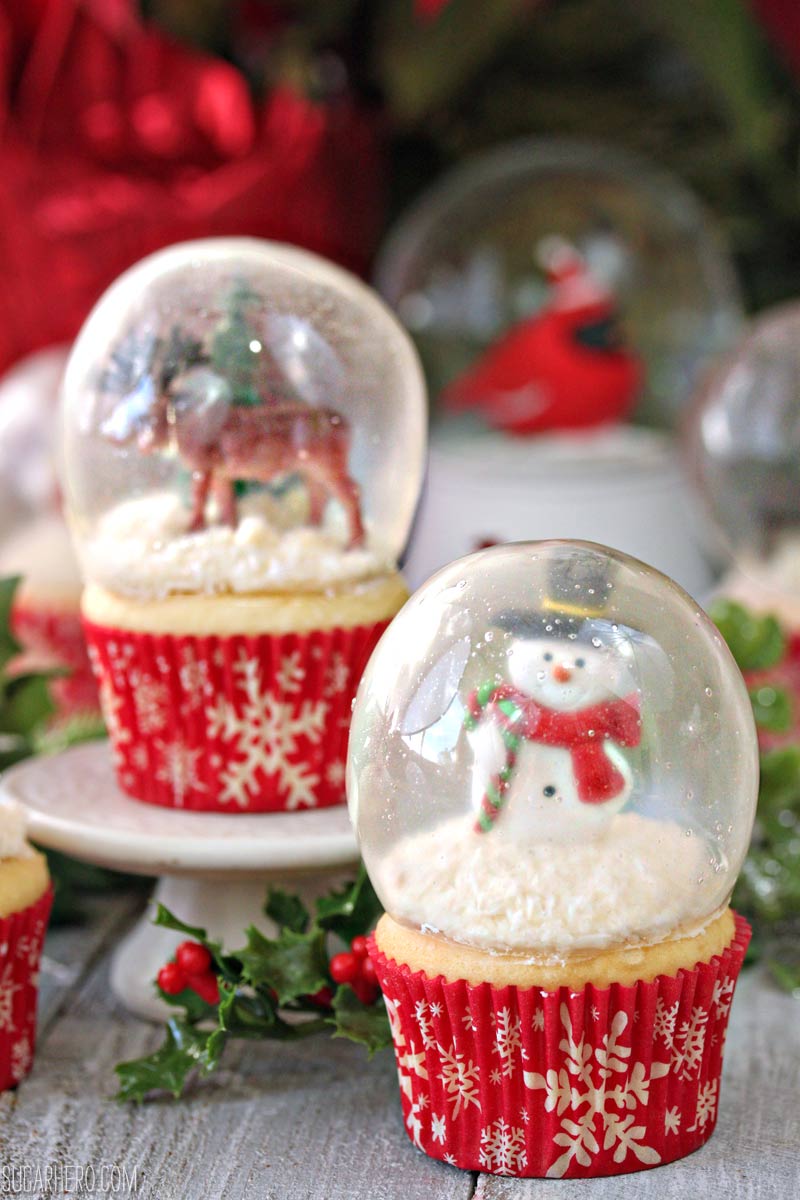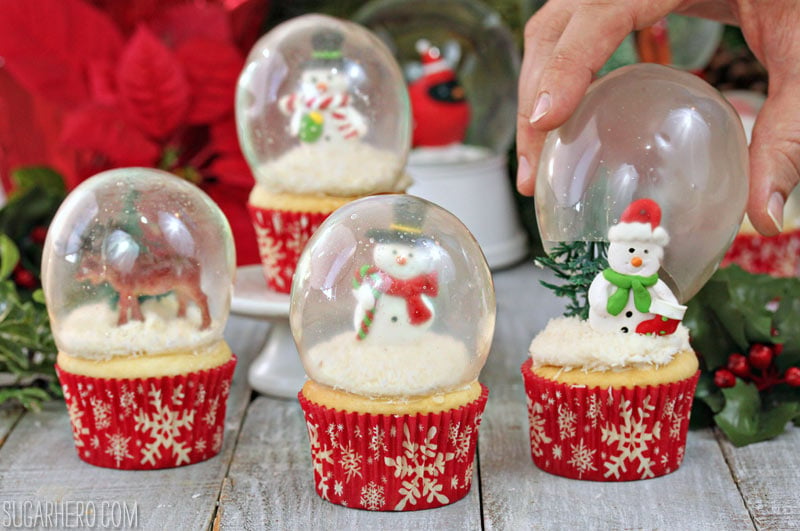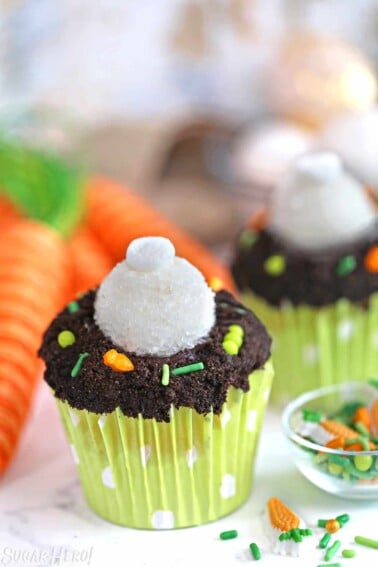These gorgeous Snow Globe Cupcakes are topped with edible gelatin bubbles. That’s right–you can eat both the cupcakes AND the globe! They look so amazing and impressive, and are perfect for the holidays!

Hello, and welcome! If you’re looking for the famous Snow Globe Cupcake recipe, you’ve come to the right place! I’m thrilled that this recipe has become so popular. I want everyone to succeed at making these, so I’ve included both a photo tutorial AND a video tutorial for you! Once you make your Snow Globe Cupcakes, please feel free to share pictures on my facebook page or tag me on Instagram–I love to see how people make this recipe their own!
When I first thought of these, it took several months of dreaming and scheming to make them a reality. It took a lot of experimenting, several last-minute gelatin purchases, some late-night disasters, and a few choice words mumbled under my breath, but at last, this Christmas dessert finally lives up to the idea in my head!
The cupcakes themselves aren’t anything special—you can use your favorite cupcake and frosting recipe, or even a box mix and canned frosting, if that’s what this crazy holiday season requires. No, the real stars of the show, and the reason I’m still finding gelatin drips in the corners of my kitchen, are the beautiful gelatin bubbles perched on top of each cupcake.

My inspiration:

The bubbles are made of gelatin and water, so although they’re technically edible, they’re probably nothing you are going to want to eat. In that way, they’re like royal icing or gum paste decorations on cakes—they won’t hurt you if you eat them, but there are lots of things that are way more tasty. You’ll probably want to focus your attention on the cupcake underneath, anyhow.

I used regular vanilla cupcakes and topped them with a thin layer of vanilla buttercream, then I rolled the tops in shredded coconut. If you’re using standard water balloons like I was, you’ll probably want to make sure to leave a margin along the edges of the cupcake, because the gelatin balloon will be a little smaller than the cake and you want to keep the coconut “snow” inside the balloon’s walls.
To fill the snow globes, I used some trinkets I found at the local craft store and cake supply store: cute little snowmen, reindeer, evergreen trees…and maybe a dinosaur or two I stole from my son’s collection. How funny would it be to serve your guests snow globe dinosaur cupcakes? We wish you a merry rex-mas…

I first read about gelatin bubbles when I pinned this gorgeous pearl cake from Cake Central, and I first saw them on cupcakes when Heather made these Bubble Gum Frosting Cupcakes. The actual method isn’t too hard, and if you prepare them like those tutorials suggest, you probably have the ingredients (powdered gelatin and water) in your house already.
However, all of the tutorials I saw for gelatin bubbles assumed that I’d want to add food coloring or luster dust or some sort of coloring agent to the gelatin. When I made my first batch of bubbles, I was disappointed to see that they were a cloudy, dingy beige color, with lots of air bubbles and a murky appearance. This might not be a problem if I was going to add color to them, but I wanted them to look transparent, like glass. Instead, they looked like the bubbles on the right:

Left: bubbles from gelatin sheets Right: bubbles from powdered gelatin
The bubbles had the right shape, but I couldn’t get over how sad and dirty they appeared. Maybe they would work for a “vintage” snow globe look, but I didn’t want to make gelatin snow globes like you’d find in your grandma’s attic—I wanted pristine, clear snow globes! And so the quest began…

Eventually, my experiments led me to these platinum gelatin sheets. Gelatin sheets, also known as leaf gelatin or gelatine, are what I’ve always used in professional kitchens. Although I believe they’re much more common in other parts of the world, in the US they’re rarely found in regular grocery stores, and instead, we have easy access to powdered gelatin, like Knox brand. The powdered gelatin works well for most applications, but if given a choice, I’d choose gelatin sheets every time. They’re easy to work with, and they have a cleaner texture, clearer color, and less of a strong “gelatin” taste. There is much more to be said about the differences between types of gelatin, but why would I go on about it when David Lebovitz has already written a great post all about gelatin?
Gelatin sheets come in different strengths (bronze, silver, gold, and platinum), and I chose the highest grade, platinum, because it is the strongest, purest, and clearest available. (If you only have access to a different grade of gelatin sheets, you can absolutely make these gelatin balloons work, but you might have to adjust the gelatin/water ratio to get the perfect texture.) All of my trials and experiments were worth it, however, when I finally nailed my method and recipe. The gelatin balloons made with platinum gelatin sheets were strong and beautifully, gloriously clear. They are very difficult to photograph because of the glare, but you’ll have to believe me that they look amazing in person.

Here’s a quick and dirty photo tutorial showing how it’s done! Bloom the gelatin, dissolve it with a bit of water, attach water balloons to skewers, then dunk the balloons. I liked the look of a single dunk the best—just one coating of gelatin produced balloons that were crystal-clear– but the gelatin balloons weren’t quite strong enough when they were coated with just one layer. The single-dipped balloons would crinkle as they were being released, and although they could be popped back into shape, the crinkling left wrinkles in the balloons that made them look less than perfect. I settled for dipping my balloons twice, which produced gelatin bubbles that were mostly clear, but were a bit less transparent and had more surface bubbles as well.
One step that’s not show in the tutorial is the very important step of greasing the balloons ever so slightly. This is a science second only to safe-cracking in its difficulty and reliance on detail! Too much grease and the gelatin won’t stick to the balloon, but omit it and you’ll have a tough time removing the balloon at all. The method that worked the best for me was to spray my hands with nonstick cooking spray, rub them together to get it to absorb, then to rub my hands on the balloons to transfer some of the oil. Just the lightest coating possible is all you need for happy balloons that release easily and cleanly.

The other thing to know about these gelatin balloons is that they take a long time to set—I gave each of my batches a solid 24 hours at room temperature to harden. Yours might be done before this time, and the process is faster if you keep them in front of a fan the whole time, but to be safe, leave yourself at least a day to assemble them.

And THAT is how you write a novel about gelatin bubbles! Sorry/not sorry for the technical minutia. Even if you have no interest in making them yourself, I hope that at least part of it was interesting, or that you enjoyed laughing at my pathetic early attempts! And if nothing else, you can raise an eyebrow at my clashing stripes in one of the tutorial pictures. I aim to entertain, in any possible way. Now go out there and make some edible snow globes!
A NOTE ABOUT THE GELATIN: It can sometimes be hard to source the platinum gelatin sheets–they tend to be sold out occasionally. I’ve personally tried this recipe with gold-level sheets and it works just fine, so if you can’t find platinum sheets, these gold sheets work as well. If you only have access to powdered gelatin, please read the note at the bottom of the recipe–it will tell you how to use powdered instead.
More Holiday Recipes 🎄
- Pecan Snowball Cookies
- Gingerbread Cookie Mug Toppers
- Vintage Christmas Card Cakes
- Peppermint Hot Chocolate
- Oreo Cookie Christmas Ornaments
- Gingerbread Christmas Cookie Tree
- Peppermint Affogato

Christmas Pinwheel Cookies

Edible Christmas Cookie Boxes Recipe

Gelatin Bubbles
Ingredients
- 12 sheets of platinum gelatin
- Ice water
- 8 water balloons
- Wooden skewers, tape, and styrofoam
- Nonstick cooking spray
Instructions
- Fill a bowl with ice water. Add the gelatin sheets one at a time, making sure that they are separated and not in a big clump, and submerge them in the cold water. Let them sit and soften for 10 minutes.
- Once they are soft, remove the sheets from the water and gently squeeze out all the excess water back into the bowl. Place the wrung-out gelatin sheets and 3 tbsp of water from the bowl into a small saucepan.
- Heat the gelatin over LOW heat, swirling the pan occasionally, until the gelatin is melted. You are not trying to get it hot, so watch it carefully and remove the pan once the gelatin is mostly melted! If it is warm, let it cool until it is no longer warm to the touch, but is still fluid. If it starts to set at any time during this process, return it to low heat briefly just until it becomes liquid again.
- Blow up 8 water balloons to your desired size. Securely tape them to long wooden skewers. Spray nonstick cooking spray on your hands, and rub your hands together until most of the oil is absorbed. Gently rub your hands on the balloons, transferring just a little oil to them—they should not be shiny or greasy at all, or the gelatin won’t stick. You should be able to do several balloons before spraying your hands again.
- Transfer the gelatin to a small cup or bowl, narrow enough so that it will be fairly deep when you dip the balloons. Dip one in the gelatin entirely, turning it until it is nearly covered—it’s okay to leave the part near the knot/skewer uncovered. Let the excess gelatin drip back into the bowl, and once it has stopped dripping, stick the skewer in the Styrofoam board. Repeat until all of the balloons have an initial gelatin layer.
- Let the balloons set for about 10 minutes, until they are no longer tacky to the touch. If necessary, re-warm the gelatin just until it is fluid, but do not make it warm again—if it feels warm, let it cool to room temperature. Re-dip the balloons a second time, then place them back on the Styrofoam board. Let the gelatin balloons sit at room temperature for about 24 hours. If you want to speed up the process, you can place them in front of a low fan, which might cut your time in half or even a quarter.
- The balloons are done when they feel hard, like plastic or egg shells, when you tap them with a fingernail. They should not feel soft at all. To release them, cut a hole in the balloon near the stem. Ideally, the balloon will shrivel up and release easily, pulling itself away from the sides of the gelatin. If it doesn’t pull away right away, don’t fret and don’t pull on it yourself. Set the balloon aside and work on the others. The balloon will naturally shrink on its own and gradually pull away from the sides. It might take 5 minutes or it might take 45, but eventually the balloon will pull away from the gelatin.
- Gelatin balloons can be stored indefinitely in an airtight container at room temperature.
Recipe Notes
Measuring Tips
Our recipes are developed using weight measurements, and we highly recommend using a kitchen scale for baking whenever possible. However, if you prefer to use cups, volume measurements are provided as well. PLEASE NOTE: the adage “8 oz = 1 cup” is NOT true when speaking about weight, so don’t be concerned if the measurements don’t fit this formula.
Want to learn more about baking measurements and conversion?
Nutrition

Snow Globe Cupcakes
Ingredients
- 8 cupcakes, baked and cooled
- 8 oz frosting of your choice, (1 cup)
- Flaked coconut
- Snow globe-appropriate cupcake toppers like snowmen, Santas, reindeer, trees, etc
- 8 gelatin bubbles
Instructions
- Transfer the frosting to a piping bag fitted with a round tip, or a plastic bag with a hole cut in the corner. Pipe a thin ring of frosting on top of the cupcakes, leaving a margin around the edges so that the gelatin bubble can enclose the frosting entirely.
- Roll the top of the cupcakes in the flaked coconut. Add a cupcake topper or two to each cupcake—if it helps, you can glue a toothpick onto the back and use that the secure the toppers to the cupcakes.
- Trim off the bottom of the gelatin bubbles, making a hole big enough to fit on top of the cupcake around the frosting. Carefully place a bubble on top of each cupcake. The bubbles will last indefinitely, but if they’re exposed to a lot of moisture in the refrigerator or the frosting, they might eventually start to soften and lose their shape.
Video
Measuring Tips
Our recipes are developed using weight measurements, and we highly recommend using a kitchen scale for baking whenever possible. However, if you prefer to use cups, volume measurements are provided as well. PLEASE NOTE: the adage “8 oz = 1 cup” is NOT true when speaking about weight, so don’t be concerned if the measurements don’t fit this formula.
Want to learn more about baking measurements and conversion?
Nutrition





















I’m having problems getting the gelatin to even stick to the ballon. Once dipped all just come off. What am I doing wrong?
Hi Courtney, I am sorry you are having trouble with the gelatin sticking to the balloon. I know that other readers have had success making sure the balloons used are fully inflated. If you’d like some assistance troubleshooting feel free to email Elizabeth at elizabeth@sugarhero.com.
Hi Elizabeth
I am wondering, when you soak the gelatin sheets in the ice water, can you use “sugar” water that you’ve boiled together so the “sugar” dissolves? Put the ice in the “sugar” water. Add the gelatin sheets, let soak for the 10 minutes, squeeze out the excess water, the place the gelatin with 3 tablespoons of “sugar” water? Then continue with your recipe?
I was just curious to see if that would take the smell away and make it taste better.
Hi Patricia, as far as using “sugar water” as you’ve described, that should do the job to soften the gelatin sheets! Since I haven’t tried it, I’m not sure what effect it would have on the flavor. Come back and let us know how it works!
I found these cupcakes by accident and think they would be great for a formal fundraising dinner. My question is what is the cost to make them?
Hi Maria! Because the product cost will differ for everyone based on location and product availability, I can’t give an accurate estimate for the entire cost to make these cupcakes and gelatin bubbles. Let me know if you have any other questions regarding the recipe!
I may never make these, but I plan to try. Thank you for sharing the results of your hard work and providing clear, detailed instructions for us. I look forward to checking out your other posts.
Hello Barbara! I’m glad my post is user-friendly. Please don’t hesitate to reach out if you need any help when you get ready to make these. All the best!
So cool! I wonder if you added some edible glitter to the gelatin if that would look cool!
Hi Meghan! I haven’t tried that but I bet it would look cool!
Just a thought but could you add some peppermint extract to the bubbles to give them some flavor? I’m not sure how you would add it exactly, maybe just put some extract on your finger and dot the bubbles.
Hi Debra! You can add a bit of extract – unfortunately, the gelatin is not sweet on its own, so while it would have a slight minty taste, IMO it still wouldn’t be super pleasant to munch on. You could add the extract to the water you use to rehydrate the gelatin and I think that would work to infuse the flavor. Let us know if you give it a try!